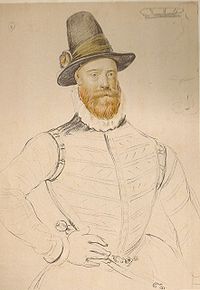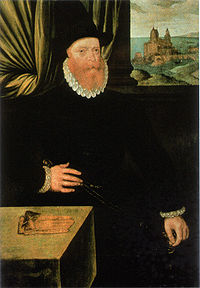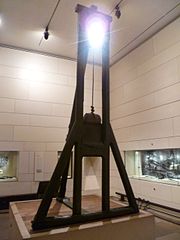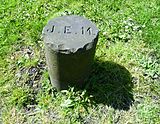- James Douglas, 4th Earl of Morton
-
James Douglas, jure uxoris 4th Earl of Morton (c. 1525 – 2 June 1581) was the last of the four regents of Scotland during the minority of King James VI. He was in some ways the most successful of the four, since he did manage to win the civil war which had been dragging on with the supporters of the exiled Mary, Queen of Scots. However he came to an unfortunate end: during his time as regent he introduced the maiden, a primitive guillotine, to Scotland, and he was eventually executed by it himself.
Contents
Biography
James Douglas was the second son of Sir George Douglas of Pittendreich. Before 1543 he married Elizabeth (d. 1574), daughter of James Douglas, 3rd Earl of Morton. In 1553 James Douglas succeeded to the title and estates of his father-in-law, including Dalkeith House in Midlothian, and Aberdour Castle in Fife. He took part in the unsuccessful embassy to England in November 1560 to treat for the marriage of Elizabeth I of England to the Earl of Arran.[1] In 1563 he became Lord Chancellor of Scotland. Though his sympathies were with the reformers, he took no part in the combination of Protestant reformers in 1565, but he headed the armed force which took possession of Holyrood palace in March 1566 to effect the assassination of David Rizzio, and the leading conspirators adjourned to Morton's house while a messenger was sent to obtain Queen Mary's signature to the "bond of security".
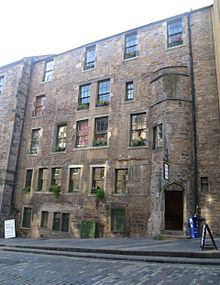 Morton's town house in Edinburgh is now a backpackers' hostel
Morton's town house in Edinburgh is now a backpackers' hostel
The Queen, before complying with the request, escaped to Dunbar, and Morton and the other leaders fled to England. Having been pardoned, Morton returned to Scotland early in 1567, and with 600 men appeared before Borthwick Castle, where the Queen had taken refuge after her marriage to Bothwell. Morton attended the remarkable conference at Carberry Hill (June 1567), and he also took an active part in obtaining the consent of the queen at Lochleven to an abdication (July 1567). He led the vanguard of the army which defeated the queen's forces at the Battle of Langside in 1568, and he was the most valued privy counsellor of the Earl of Moray during the latter's brief term of office as regent. On the death of the Earl of Mar (28 October 1572), Morton, who had been the most powerful noble during this regency, and also during that of the Earl of Lennox, at last reached the object of his ambition by being elected regent.
In many respects Morton was an energetic and capable ruler. He effected at Perth, in February 1573, with the aid of Elizabeth of England's envoy, a pacification with George Gordon, 5th Earl of Huntly, the Hamiltons and the Catholic nobles who supported Mary. Only Edinburgh Castle held out, and this, aided by English artillery, he succeeded in taking after a brave resistance by Kirkcaldy of Grange and Maitland of Lethington.
The ensuing execution of these men put an end to the last chance of Mary's restoration by native support. But while all seemed to favour Morton, under-currents combined to procure his fall. The Presbyterian clergy were alienated by his leaning to Episcopacy, and all parties in the divided Church disliked his seizure of its estates. Andrew Melville, who had taken over as leader from John Knox, was firmly against any departure from the Presbyterian model, and refused to be won by a place in Morton's household. As well as the pressure from the Presbyterians, Colin Campbell, 6th Earl of Argyll and John Stewart, 4th Earl of Atholl, both leading Roman Catholics and members of the Queen's party in league with Alexander Erskine, governor of Stirling Castle and the custodian of young King James, received such widespread support, that Morton had no option but to resign his Regency.
He surrendered Edinburgh Castle, Holyrood Palace, the Great Seal and the Honours of Scotland, retiring to Lochleven, where he busied himself in laying out gardens. But his ambition could not deny itself another stroke for power. Aided by the young earl of Mar, he got possession of Stirling Castle and the person of the king. Civil war was avoided only by the influence of Sir Robert Bowes, the English ambassador. A nominal reconciliation was effected, and a parliament at Stirling introduced a new government. Morton, who secured an indemnity, was president of the council, but Atholl remained a privy councillor in an enlarged council with the representatives of both parties. Shortly afterwards Atholl died (allegedly of poison) and suspicion pointed to Morton. His return to power was brief, and the only important event was the prosecution of the two Hamiltons, who still supported Mary and saved their lives by flight to England. The final fall of Morton came from an opposite quarter.
In September 1579 Esmé Stewart, Sieur d'Aubigny, the king's cousin, came to Scotland from France, gained the favour of James by his courtly manners, and received the lands and earldom of Lennox, the custody of Dumbarton Castle, and the office of chamberlain. One of his dependents, James Stewart of Bothwellmuir, son of Lord Ochiltree and brother-in-law of Knox, had the daring to accuse Morton at a meeting of the council in Holyrood of complicity in the murder of Darnley, and he was at once committed to custody. Some months later Morton was condemned by an assize for having taken part in that crime, and the verdict was justified by his confession that Bothwell had revealed to him the design, although he denied participation in its execution.
Execution
He was executed on the 2nd of June 1581. The method of his execution was the "maiden" — a guillotine based on a model of the Halifax Gibbet, which he had brought personally from England, having been "impressed by its clean work".[2] His corpse remained on the Scaffold for the following day, until it was taken for burial in an unmarked grave at Greyfriars Kirkyard. His head however remained on "the prick on the highest stone"[3] (a spike) on the north gable of the ancient Tolbooth of Edinburgh (outside St Giles Cathedral) for eighteen months until it was ordered to be reunited with his body in December 1582.[4] Although Morton's final resting place is allegedly marked with a small sandstone post incised only with the initials "J.E.M." for James Earl of Morton, this is simply a Victorian marker for a lair edge, twisted in meaning for convenience. Logically, were a marker allowed (which was not permitted for executed criminals) firstly it would more logically read "J.D.", and secondly it would have been cleared away in 1595 when all stones were removed from Greyfriars.
The attainted earldom of Morton passed by charter at his death to a grandson of the 3rd earl, John Maxwell, 7th Lord Maxwell (1553-1593), who had previously claimed the title. In 1586, however, the attainder was rescinded in favour of Archibald Douglas, 8th Earl of Angus, a nephew of the 4th earl.
Drochil Castle
James Douglas started building Drochil Castle in 1578, three years before his death. It was no more than half built and never finished. The ruins of the castle overlook Peebles and the valleys of the Tarth Water, Lyne Water and River Tweed.
Notes
References
 This article incorporates text from a publication now in the public domain: Chisholm, Hugh, ed (1911). Encyclopædia Britannica (11th ed.). Cambridge University Press.
This article incorporates text from a publication now in the public domain: Chisholm, Hugh, ed (1911). Encyclopædia Britannica (11th ed.). Cambridge University Press.- Sir Herbert Maxwell Bart.,FRS,LLD., A History of the House of Douglas II Vols, Freemantle and Co., London MCMII
See also
Government offices Preceded by
The Earl of MarRegent of Scotland
1572–1578Succeeded by
noneMilitary offices Preceded by
UnknownLord High Admiral of Scotland
1567 –Succeeded by
UnknownPolitical offices Preceded by
The 4th Earl of HuntlyLord Chancellor of Scotland
1563–1566Succeeded by
The 5th Earl of HuntlyPreceded by
The 5th Earl of HuntlyLord Chancellor of Scotland
1567–1573Succeeded by
The 5th Earl of ArgyllPeerage of Scotland Preceded by
James DouglasEarl of Morton
1553 – 1581Succeeded by
Archibald DouglasCategories:- Earls in the Peerage of Scotland
- Lord High Admirals of Scotland
- Burials at Greyfriars Kirkyard
- Regents of Scotland
- Scottish soldiers
- Scottish people executed by the maiden
- House of Douglas and Angus
- Peers jure uxoris
- People executed under the Stuarts
- 1520s births
- 1581 deaths
- Lords of the Congregation
- Members of the Privy Council of Scotland
- Members of the pre-1707 Scottish Parliament
Wikimedia Foundation. 2010.

